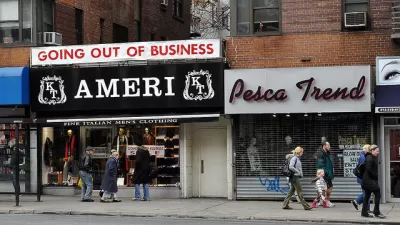For a city famous for high cost of living, incredible demand for housing, famous examples of gentrification, and political pressure to build, New York City is lagging behind the volumes of residential construction approved in comparable cities.
According to an article by Laura Kusisto and Eliot Brown, "the number of units authorized in New York City through building permits remains well below levels before the market crashed in late 2008, according to U.S. Census Bureau figures."
"In New York, permits for 17,995 new housing units were issued in 2013, slightly more than half the nearly 34,000 units authorized in 2008 and below the number approved for 2002."
Kusisto and Brown cite San Francisco, Boston, Washington D.C., and Seattle as cities that are issuing permits at pre-crash levels—San Francisco, in fact, issued almost twice as many permits in 2013 as it did in 2005.
The explanation for the sluggish building industry, according to real-estate analysts and developers mentioned in the article: "a combination of factors they say have made New York an increasingly inhospitable place to build housing."
Stephen Miller, writing for New York YIMBY, provides a different explanation than the traditional arguments of "high land costs, high construction costs, overuse of landmarking." Instead, Miller suggests we look " far beyond the gentrifying fringe" for the real cause of New York's tepid rebound. "Put simply," writes Miller, "New York City’s small builders have been nearly eradicated. The segment of the market that normally produces about half the city’s new building stock has all but vanished."
FULL STORY: Residential Construction in New York City Lags

Planetizen Federal Action Tracker
A weekly monitor of how Trump’s orders and actions are impacting planners and planning in America.

Map: Where Senate Republicans Want to Sell Your Public Lands
For public land advocates, the Senate Republicans’ proposal to sell millions of acres of public land in the West is “the biggest fight of their careers.”

Restaurant Patios Were a Pandemic Win — Why Were They so Hard to Keep?
Social distancing requirements and changes in travel patterns prompted cities to pilot new uses for street and sidewalk space. Then it got complicated.

Platform Pilsner: Vancouver Transit Agency Releases... a Beer?
TransLink will receive a portion of every sale of the four-pack.

Toronto Weighs Cheaper Transit, Parking Hikes for Major Events
Special event rates would take effect during large festivals, sports games and concerts to ‘discourage driving, manage congestion and free up space for transit.”

Berlin to Consider Car-Free Zone Larger Than Manhattan
The area bound by the 22-mile Ringbahn would still allow 12 uses of a private automobile per year per person, and several other exemptions.
Urban Design for Planners 1: Software Tools
This six-course series explores essential urban design concepts using open source software and equips planners with the tools they need to participate fully in the urban design process.
Planning for Universal Design
Learn the tools for implementing Universal Design in planning regulations.
Heyer Gruel & Associates PA
JM Goldson LLC
Custer County Colorado
City of Camden Redevelopment Agency
City of Astoria
Transportation Research & Education Center (TREC) at Portland State University
Camden Redevelopment Agency
City of Claremont
Municipality of Princeton (NJ)





























